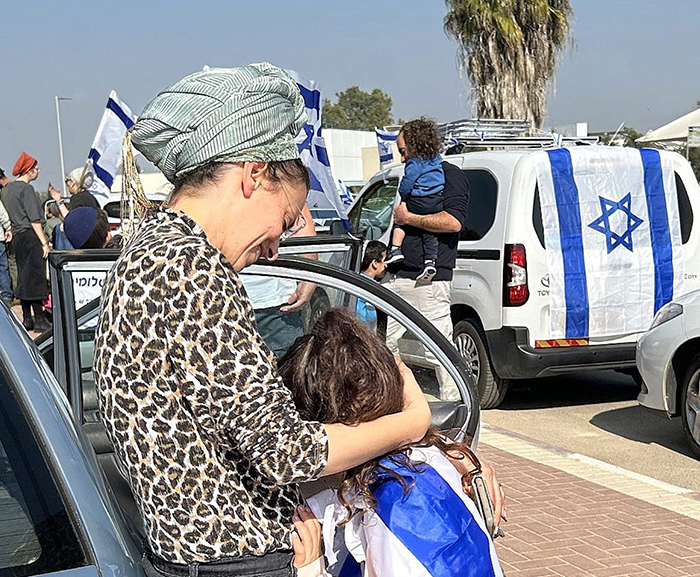Eighty-two families evacuated from Shlomit on Oct. 8, 2023 prepare to return home, Feb. 29, 2024. Photo courtesy of Judy Lash Balint.
JNS
How do people have the fortitude to go back to the place where they were terrorized on Oct. 7? For the residents of Shlomit, the answer is, in a convoy. Together, as a unit, focused on continuing the Zionist enterprise started by families evicted from their homes in Gush Katif in 2005.
Shlomit is one of the villages in the northwest Negev on Israel’s borders with Egypt and Gaza, known as the Halutza Communities.
Recently, the 82 families from Shlomit who were evacuated on Oct. 8 gathered at the Eshkol Regional Council, less than 3 miles from the Gaza border, and traveled in a noisy, flag-decked convoy of cars back to their community.
JNF-USA has invested heavily in supporting the development of the area, which boasts of innovative agricultural initiatives, educational institutions for all ages and a highly educated population. The return to Shlomit included a ceremony to lay the cornerstone of a JNF-USA fortified daycare center.
The Strength To Go On
The atmosphere as the convoy set out was tinged with sadness; the community is still mourning four members of the Shlomit First Responder Team who were killed on Oct. 7 fighting terrorists who invaded the neighboring village of Pri Gan. Their actions prevented a massacre there.
Nechama Bibi, 27, whose husband Uriel, 30, was one of those killed on Oct. 7, welcomed her friends and neighbors from the convoy at the site of the planned daycare center. Uriel, a paratrooper who had recently begun training to become a paramedic, had two daughters, ages 2 and 4.
Bibi told JNS that the return of the community gives her stability, support and the strength to go on. The family had moved into their first permanent home just six weeks before Oct. 7, after four years of living in a caravan. For the past few months “we were on hold,” said Bibi. “We didn’t really deal with the absence of Uriel. Now to come home alone to the place that was really his, is really very difficult. But it’s a kind of hope, to come home to the place that’s ours.”
Questions Future
Like many of her neighbors, She said that she’s not afraid regarding the security situation because of the Israel Defense Force presence nearby amid the war with Hamas. “But the fact that we don’t know what’s going to be in Gaza after the war, and the possibility that the IDF will pull out sometime…is scary,” she added.
The Shlomit convoy was met along the way and at the gated entrance to the village by dozens of cheering, flag-waving residents of nearby communities who had only recently returned.
“Best Option”
Before the convoy set off, Shlomit and Idan, parents of three young kids, told JNS that the decision to return was taken by the entire community, and was the best of the options presented to them. “The thought of starting from scratch somewhere completely new was something we just couldn’t imagine,” said Shlomit.
Economy Of Shlomit
“Life here will never go back to what it was before Oct. 7 because of the things we lost. We lost friends and we lost our innocence and our trust in those who were supposed to protect us,” she said. “It’s all very sensitive and painful and it will take us all some time to recuperate.” Her brother-in-law was killed in the war.
“Despite everything, Shlomit is expanding, another 30 families are coming to live here, and people are having lots of kids. We need this new day care center,” she added.
Unlike the surrounding communities, Shlomit’s economy is not based on agriculture, so it has been less affected economically by the war. Most of the families in Shlomit are professionals working as engineers, in high tech, as social workers, teachers and physical therapists. Nevertheless, the trauma of the Oct. 7 attack, the loss of friends and family and the months-long displacement have left their mark.
Fighting Fears
Ariel and Shira Avchayon left their home in Shlomit on Oct. 8 with three kids and returned with four. Baby Eyal was born two weeks ago while they were living in a Jerusalem area hotel. “We’re coming back strong and proud, with our heads held high. We’re looking to the future,” Ariel told JNS.
“All the communities here are full of people with lots of strength, but there are some who are afraid, so I hope this step of ours to return will be an example to others,” he said.
Hope
He expressed the hope that new communities will be created to revitalize the region “after everything that happened here.”
Security has been doubled, he said, with the addition of soldiers stationed inside the community. “We want to believe that things are going to be safe. We have a great security team, and we trust that the IDF has learned the lessons of Oct. 7. Our awareness and preparedness are on a different level now and we’ll be O.K.,” he added.
Now that the 500 residents of Shlomit have come home after almost five months of displacement, Bibi says she realizes that what she calls “the hold” was actually helpful from the point of view of grieving, “but it stopped our lives. Now we can try to restore our lives. On the one hand we have a lot of pain, but on the other hand, a lot of hope.”








